The Micro Hotel Market is estimated to be valued at USD 100.0 billion in 2025 and is projected to reach USD 174.1 billion by 2035, registering a compound annual growth rate (CAGR) of 5.7% over the forecast period.
The Micro Hotel market is witnessing significant growth driven by the increasing preference for compact and cost-effective lodging solutions among travelers seeking convenience, accessibility, and personalized experiences. The future outlook for this market is shaped by the growing adoption of digital booking platforms and the rise of short-stay tourism, particularly in urban and high-traffic destinations.
Advancements in technology have enabled hotels to provide seamless online reservations, contactless check-in, and tailored services, which enhance customer satisfaction and operational efficiency. Rising disposable incomes and the growing trend of domestic and short-duration travel are further supporting market expansion.
Additionally, micro hotels offer flexible pricing, strategic locations, and modern amenities that appeal to both business and leisure travelers, making them a preferred choice for spontaneous and budget-conscious trips As travel preferences shift towards convenience, personalization, and accessibility, micro hotels are positioned to capture a larger share of the lodging market, with continued growth potential in both established and emerging tourism destinations.
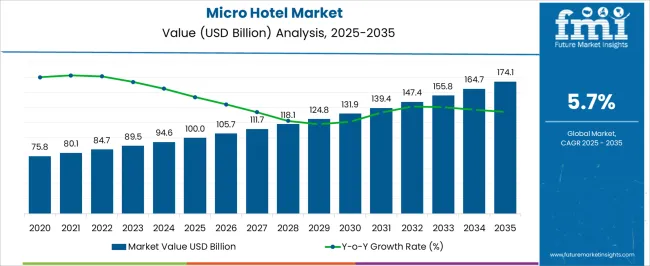
| Metric | Value |
|---|---|
| Micro Hotel Market Estimated Value in (2025 E) | USD 100.0 billion |
| Micro Hotel Market Forecast Value in (2035 F) | USD 174.1 billion |
| Forecast CAGR (2025 to 2035) | 5.7% |
The market is segmented by Booking Channel, Tourist Type, Tour Type, Consumer Orientation, and Age Group and region. By Booking Channel, the market is divided into Online Booking, Phone Booking, and In-Person Booking. In terms of Tourist Type, the market is classified into Domestic and International. Based on Tour Type, the market is segmented into Package Travelers, Independent Travelers, and Tour Groups. By Consumer Orientation, the market is divided into Men and Women. By Age Group, the market is segmented into 26 To 35 Years, 15 To 25 Years, 36 To 45 Years, 46 To 55 Years, and 66 To 75 Years. Regionally, the market is classified into North America, Latin America, Western Europe, Eastern Europe, Balkan & Baltic Countries, Russia & Belarus, Central Asia, East Asia, South Asia & Pacific, and the Middle East & Africa.
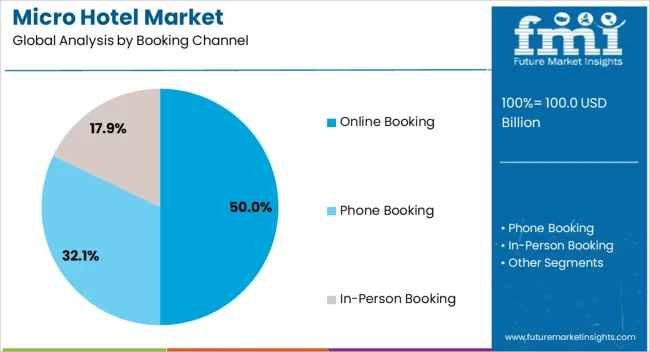
The online booking channel is projected to hold 50.00% of the Micro Hotel market revenue share in 2025, establishing it as the leading booking method. This growth is driven by the convenience, speed, and accessibility offered by digital platforms, allowing travelers to compare prices, view real-time availability, and secure reservations efficiently.
The widespread use of smartphones and travel apps has accelerated the adoption of online booking, particularly among tech-savvy travelers seeking instant confirmations and flexible payment options. The integration of AI-driven recommendation systems and personalized offers enhances the user experience, encouraging repeat bookings.
Moreover, online booking platforms facilitate broader market reach for micro hotels, including domestic and international travelers, thereby supporting revenue growth The continuous investment in digital marketing and enhanced platform functionality further reinforces the dominance of the online booking segment.
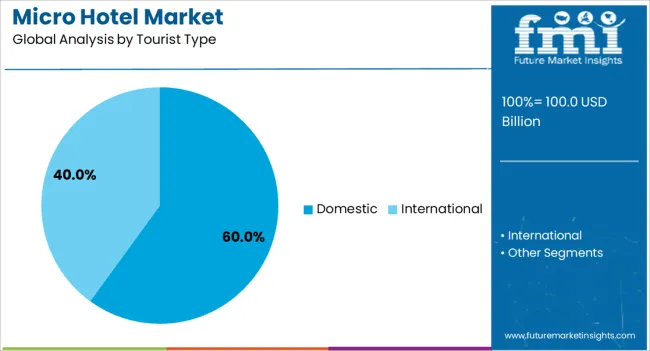
The domestic tourist segment is expected to capture 60.00% of the Micro Hotel market revenue share in 2025, highlighting the rising preference for local travel experiences. Growth in this segment is influenced by the increasing number of domestic travelers seeking short stays and convenient accommodation options that align with budget and itinerary flexibility.
Factors such as improved transportation infrastructure, government tourism initiatives, and the popularity of weekend getaways have driven domestic travel demand. Micro hotels offer strategic locations, easy access to urban centers, and essential amenities that cater specifically to domestic tourists.
Additionally, the adoption of online booking channels enables seamless planning and travel management, further boosting the segment’s appeal The focus on personalized services and localized experiences has reinforced the position of domestic tourists as a leading segment within the market.
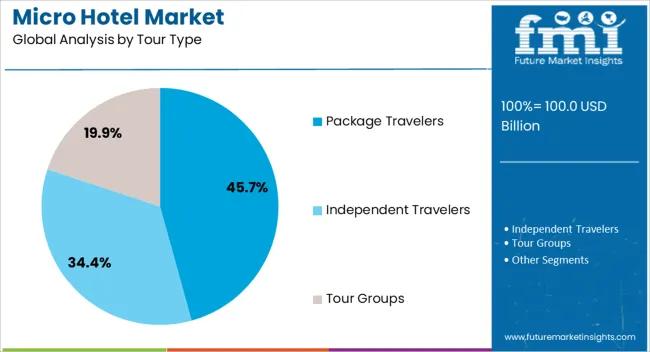
The package travelers segment is anticipated to account for 45.70% of the Micro Hotel market revenue share in 2025, making it a leading category in terms of tour type. The growth of this segment is driven by the convenience and cost-effectiveness offered through bundled travel packages, which often include accommodation, transportation, and curated experiences.
Travelers increasingly prefer package solutions to reduce planning complexity, optimize itineraries, and ensure predictable costs. Micro hotels complement this demand by providing compact, strategically located, and service-oriented lodging options suitable for packaged tours.
The adoption of technology in travel agencies and online platforms enhances the booking and management of package tours, further supporting segment growth The alignment of micro hotel offerings with the preferences of package travelers continues to strengthen this segment’s contribution to overall market revenue.
Micro Hotel Market to be a Key Trend in the Hospitality Sector
In the hotel and lodging sector, industry players are able to enhance the visitor experience, offer convenience, and bring in more money. Great customer service is the primary objective since it encourages client loyalty and great word-of-mouth recommendations. Healthy interpersonal skills, organizational prowess, and a thorough comprehension of client demands are prerequisites for hospitality workers.
Micro markets provide a warm atmosphere that makes visitors feel at ease and well-cared for. Accommodations appeal to a variety of traveler types and enhance the allure and competitiveness of hotels by providing flexibility, convenience, and choice. These outlets are open around the clock and provide drinks, snacks, and convenience foods, which is very useful for late-night or erratic visitors. Such an approach works especially well for guests arriving late at night or individuals whose schedules conflict.
Increasing Demand for Tech-Savvy Accommodations Pushes Deals in Busy Residences
Micro hotels are distinct in the way businesses use technology to provide outstanding visitor experiences. These lodging facilities have digital amenities in the rooms, smart lighting and temperature controls, and automated check-in systems. Organizations are well-liked by tech-savvy tourists because of the distinctive concepts and convenient design of these hotels.
Micro hotels frequently demand for technology to improve client satisfaction and optimize operations. Technology might include digital control panels for lighting, temperature, and entertainment in the rooms. It could also involve self-check-in kiosks, keyless entry systems, and smartphone applications for making reservations and using hotel services.
In places with high population density, where every square inch matters, these hotels are especially well-suited. The minimalist accommodations are affordable and pleasant due to their compact size, which makes the lodging accommodations fit into any setting. Due to the miniature size, these hotels are also able to snag desirable locations and develop into handy hubs for visitors looking to explore the city from a central position.
Eco-logical Accommodations Gratifies Sustainable Practices
Solar panels and natural air fresheners are a couple of the few resources used by eco-friendly micro hotels, which place a high priority on sustainability. Such economical hotels encourage recycling and cut down on trash. Additionally, businesses procure food from neighboring farms, drawing in eco-aware tourists.
The cost-effectiveness of micro hotels, which maximize area and facilities at reasonable prices, contributes to their popularity. These accommodations are especially well-liked in desirable urban areas since they provide opulent lodging without having to worry about the expense. By democratizing access, such a plan elevates strategically placed hotels to the top of the list for guests looking for ease and comfort. In general, tourists who are concerned about the environment are choosing micro hotels as sustainable vacation choices.
The micro hotel market has historically developed at a CAGR of 5.3%. However, travel deals for micro hotels have started to advance at a slightly better pace, displaying a CAGR of 5.7% from 2025 to 2035.
A micro hotel is a type of accommodation with fully furnished rooms at a comparatively low price. These hotels are ideal in densely populated urban centers where the demand for space is significantly high. These facilities target low-budget guests composed of both business and leisure clients.
Between 2020 and 2025, there was a transition in the hotel industry. This was propelled by the demand for unique travel experiences and sustainable tourism, as well as the rising popularity of floating hotels. There was a mix of travelers from different backgrounds who came because of the beautiful sceneries and stunning sights.
The establishments are small, with up to 10 to 100 rooms, and are sometimes referred to as boutique hotels because of their distinct design features. The hotels’ rooms are fully equipped with high-quality facilities and materials; therefore, although smaller than other apartments, they are fully functional.
Anticipated expansion and revolutionary shifts in the global miniature hotel industry are projected between 2025 and 2035. This is mostly due to the growing desire for atypical lodging alternatives and distinctive travel experiences. Future undersized hotels are anticipated to be shaped by architectural and specialized developments. Sustainable materials, energy-efficient systems, and smart technology are expected to elevate the visitor experience and set them apart from conventional land-based lodging.
Guests can choose tiny hotels and benefit from their conveniences and comfort as they experience the facilities in a hotel cheaper. These hostels are really great for persons with a low budget because they are often priced at half the cost of your typical generic hotel room.
The section below covers the forecast for the micro hotel market in terms of countries. Information on key countries in several parts of North America, Asia Pacific, Europe, and others will be provided. The demand for micro hotels in the United States is anticipated to report a CAGR of 3.5% through 2035, while the traveling sector in India is augmenting, showcasing a CAGR of 8.5%. Owing to adventure tourism in Australia, the industry is anticipated to register a CAGR of 5.8% from 2025 to 2035.
| Countries | CAGR 2025 to 2035 |
|---|---|
| United States | 3.5% |
| Germany | 4% |
| Australia | 5.8% |
| China | 7.9% |
| India | 8.5% |
The United States hospitality industry has seen a significant rise in micro hotels in urban areas, influenced by minimal design trends from Europe and Japan. The petite room trend is both design-driven and development-driven, aiming to reduce operational costs while increasing the number of rooms within a specific structure.
The United States micro hotel market is anticipated to register a CAGR of 3.5% through 2035. This trend is attracting developers in high-cost metropolises, such as New York and Chicago, to offer lower-budget rooms within smaller spaces at similar prices.
The industry in the United States primarily caters to budget-conscious millennials and business travelers seeking a functional city experience. Micro hotel rooms, with high-end finishes and quality standards, are more economical than typical rooms. They offer comfortable common spaces outside the room and enhance the comprehensive experience.
Australia's micro hotel market is experiencing a surge in adventure tourism, with a projected CAGR of 5.8% during the evaluation period. This growth is set to be manipulated by rising trends in exotic travel, trekking, hiking, and other outdoor activities.
The temporary migration of people for conditional purposes or leisure has led to industry growth in Australia. Hostels are comfortable for short-term and long-term stays, making them the primary accommodation option for travelers.
Eco-friendly lodges in Australia offer amenities like Wi-Fi, breakfast, transport, privacy, social areas, private rooms, and kitchen facilities. Social media, particularly among youth, has fueled the growth of the micro-hotel industry in Australia.
India’s micro hotel market is expected to exhibit a CAGR of 8.5% during the forecast period. The industry growth is attributed to the country's diverse landscapes, which include beaches and snowy mountains in the Northern region, as well as sandy deserts of Rajasthan and Gujarat. It also includes bustling metropolises such as Mumbai and Delhi. These attractions have been drawing tourists, particularly budget-conscious travelers, to India.
To meet the growing demand for affordable and comfortable accommodation options, micro-hotels and hostels are gaining popularity in India. Solo travelers, in particular, are often drawn to communal living options such as Zostel and Hostellers.
The section contains information about the leading segments in the industry. In 2025, men's travel is anticipated to acquire a value share of 58.1%. Package travelers are estimated to account for 45.7% of the industry in 2025.
| Segment | Men (Consumer Orientation) |
|---|---|
| Value Share (2025) | 58.1% |
As the travel and tourism sector continues to evolve, the number of male tourists is envisioned to see a significant increase in the coming years. In fact, in 2025, men are set to account for around 58.1% of the industry's share. A key factor contributing to this trend is the fact that most men tend to prefer minimal space when traveling and prioritize comfort above all else.
Micro hotels are gaining popularity among male tourists due to their compact, comfortable, and affordable accommodations. These options provide a no-frills travel experience. Communal living arrangements offer ample socializing opportunities and prospects for developing new relationships with fellow travelers.
The rise in male tourists is foreseen to influence the demand for travel experiences and accommodations significantly. This necessitates the adaptation of travel companies and service providers to cater to the unique preferences and needs of the growing demographic.
| Segment | Package (Tour Type) |
|---|---|
| Value Share (2025) | 45.7% |
In 2025, the packaged tour type segment is envisioned to make up 45.7% of the industry. This is largely due to tour operators' provision of multiple services and all-inclusive packages. Vacation packages for various tourist destinations, activity levels, and price points are widely popular among micro hotel consumers.
Coupled with the plethora of choices available, this gives tourist hotels an advantage over the significant number of people who rely on the same service providers. It thereby eliminates the inconvenience and cost of sourcing individual suppliers for each service.
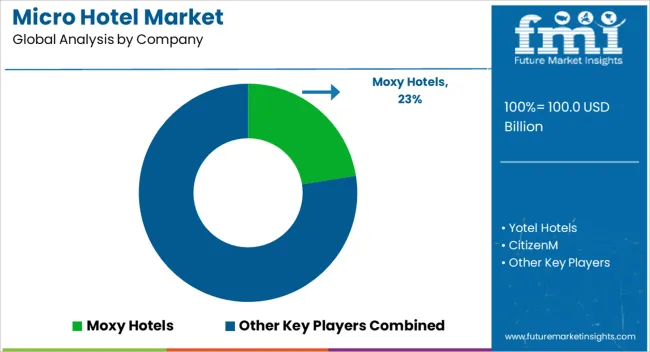
The competitiveness has grown extreme as more businesses enter the micro hotel market to satisfy the expanding need for distinctive and reasonably priced lodging. Minuscule motels have a unique offering compared to conventional hotels and hostels, but the industry needs to be more congested.
Micro hotels are popular. Thus, established hotel chains and boutique hotels have begun to enter the hospitality sector, bringing brand recognition and financial resources. A dynamic and competitive environment is being created by introducing new minimal models by local business owners and independent operators. Micro hotels must distinguish themselves with unique designs, amazing guest experiences, and value-added services to stand out and prosper in the competitive industry.
Effective marketing and branding techniques are paramount to gaining awareness and drawing clients in a crowded market. Industry players can get a competitive edge by having a strong online presence, using social media, and collaborating with travel bloggers and social media influencers.
Industry Updates
Depending on the booking channels, the industry is branched into phone booking, online booking, and in-person booking.
Based on the tourist types, the industry is bifurcated into domestic and international.
Depending on the tour types, the industry is branched into independent travelers, tour groups, and package travelers.
The industry is bifurcated into men and women based on consumer orientation.
The industry is examined across several age groups, including 15 to 25 years, 26 to 35 years, 36 to 45 years, 46 to 55 years, as well as 66 to 75 years.
Key countries of North America, Latin America, East Asia, South Asia and Pacific, Western Europe, Eastern Europe, and the Middle East and Africa are covered.
The global micro hotel market is estimated to be valued at USD 100.0 billion in 2025.
The market size for the micro hotel market is projected to reach USD 174.1 billion by 2035.
The micro hotel market is expected to grow at a 5.7% CAGR between 2025 and 2035.
The key product types in micro hotel market are online booking, phone booking and in-person booking.
In terms of tourist type, domestic segment to command 60.0% share in the micro hotel market in 2025.






Full Research Suite comprises of:
Market outlook & trends analysis
Interviews & case studies
Strategic recommendations
Vendor profiles & capabilities analysis
5-year forecasts
8 regions and 60+ country-level data splits
Market segment data splits
12 months of continuous data updates
DELIVERED AS:
PDF EXCEL ONLINE
Micro-Dosing Sachet Fillers Market Analysis - Size and Share Forecast Outlook 2025 to 2035
Microwave Source Market Size and Share Forecast Outlook 2025 to 2035
Micro-energy Harvesting System Market Size and Share Forecast Outlook 2025 to 2035
Micro CHP Market Size and Share Forecast Outlook 2025 to 2035
Micro Irrigation System Market Size and Share Forecast Outlook 2025 to 2035
Micro Flute Paper Market Size and Share Forecast Outlook 2025 to 2035
Microcrystalline Cellulose Market Size and Share Forecast Outlook 2025 to 2035
Micro Balances Market Size and Share Forecast Outlook 2025 to 2035
Micro Perforated Films Packaging Market Size and Share Forecast Outlook 2025 to 2035
Microbial Coagulants Market Size and Share Forecast Outlook 2025 to 2035
Microserver IC Market Size and Share Forecast Outlook 2025 to 2035
Microplate Handling Instruments Market Size and Share Forecast Outlook 2025 to 2035
Microsclerotherapy Treatment Market Size and Share Forecast Outlook 2025 to 2035
MicroLED Photoluminescence Inspection System Market Size and Share Forecast Outlook 2025 to 2035
Micro-Scale VFFS Modules Market Analysis - Size and Share Forecast Outlook 2025 to 2035
Microscope Digital Camera Market Size and Share Forecast Outlook 2025 to 2035
Micro Guide Catheter Market Size and Share Forecast Outlook 2025 to 2035
Micro Perforation Machines Market Size and Share Forecast Outlook 2025 to 2035
Micro Battery Market Size and Share Forecast Outlook 2025 to 2035
Microwave Monolithic Integrated Circuits Market Size and Share Forecast Outlook 2025 to 2035

Thank you!
You will receive an email from our Business Development Manager. Please be sure to check your SPAM/JUNK folder too.
Chat With
MaRIA